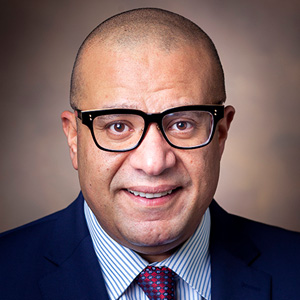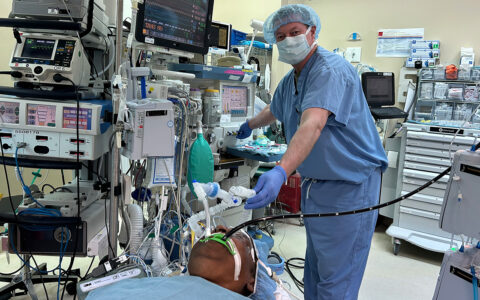Vanderbilt University Medical Center is evolving a new standard for living-donor nephrectomy using robotic-assisted techniques that benefit both patient and surgeon.
Traditionally, living-donor nephrectomies were performed using either a laparoscopic technique or open surgery. Robotic-assisted procedures, while slightly more invasive than laparoscopic alternatives, require a smaller incision while maintaining healthy organ function, says Rachel Forbes, M.D., chief of the Division of Kidney and Pancreas Transplantation at Vanderbilt.
“We have done close to 15 robotic-assisted, live-donor nephrectomies, many of them removing the right kidney, and donor renal function is equivalent to laparoscopic approaches,” she said.
Simpler Follow-up, Expanded Donor Pool
Robotic surgery has gained steam in recent years, in part due to its improved precision and consistency for high-stakes procedures. Patients receiving kidney transplants using robotic approaches benefit from lower rates of surgical-site infections and similar long-term survival rates as those undergoing more traditional surgeries.
For living donors, robotic techniques offer an appealing alternative to open surgery. Benefits include accelerated recovery and less time spent in the hospital. The advanced technique may also be useful for donors with a high body mass index.
For these reasons and more, robotic-assisted nephrectomy could help widen the donor pool, said Kareem Eid, M.D., an assistant professor of surgery at Vanderbilt. Together, Eid and Forbes performed the first robotic-assisted living-donor nephrectomy at Vanderbilt in 2021.
“For a right kidney nephrectomy in particular, we’ve found robotic-assisted surgery allows us to utilize more donors with suitable, yet challenging anatomies,” Eid said. “We have more options for excision than we would with open surgery.”
Benefits for Surgeons
Many of the patient benefits derive from the improved fidelity of robotic-assisted surgery.
“It gives you really fine motor skills and an ability to dissect, especially on the right side where the kidney has a short vein near the vena cava, to try to give better length and ability to get a greater length and dissection on the vessels,” Forbes explained.
The surgeons caution, however, that robotic procedures come with a learning curve. One study found an association between robotic-assisted living-donor nephrectomy and higher intraoperative complications.
The high-volume of kidney transplants at Vanderbilt allows surgeons plenty of opportunities to fine-tune their skills. Vanderbilt surgical science trainees also participate in robotic surgery early in their residency program to help shrink the proficiency gap.
It’s not a tough sell to get surgeons interested, Forbes said, given the provider benefits robotic surgery affords.
“It allows the surgeon to sit at a console so, ergonomically, it’s far superior,” she said. “Your visualization is much improved compared to laparoscopy because it’s 3D, not 2D. And then the robotic arms have the full rotation of a hand. They can get in there and finely turn the corners, whereas with a laparoscopy, you just have two angles.”
Looking Forward
Since their first kidney transplant in 1962, Vanderbilt surgeons have been at the forefront of transplant advances. Now, their track record on robotic-assisted living-donor nephrectomy speaks for itself – all 15 procedures performed to date remain successful, with transplant donors and recipients thriving.
“We’re hoping this is the first of a new service line – an era of robotic transplants at Vanderbilt,” Forbes added.






